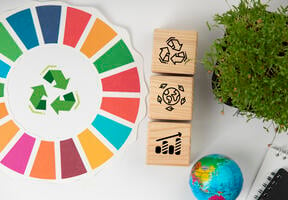The Long Development of Electric Lighting
10 min read
A symbol of the “Electricity Fairy” (itself the personification of electricity in the 19th century), the electric light bulb was first mass-marketed by Thomas Edison’s company in 1878 (see sidebar). It has since been continuously improved in terms of efficiency and performance, and its technology has been adapted to its various uses, both at home and in the office, and in electronic devices, street lighting and vehicle headlights. Today, the priority is to reduce its energy consumption.

© SCOTT OLSON / GETTY IMAGES NORTH AMERICA / AFP - Technological development seen through a photo: an old incandescent light bulb hangs between an LED lamp (left) and a compact fluorescent lamp (right)
For more than a century, the household lighting market was dominated by the incandescent light bulb, in which a filament is heated to a high temperature inside an oxygen-free glass envelope. However, due to its high energy consumption, the incandescent bulb gradually fell out of favor in Western countries, particularly in Europe. In concrete terms, 95% of the energy consumed by such a light bulb is lost as , with only the remaining fraction being converted into light (whose unit is the lumen1). Despite its benefits in rendering surrounding colors, its efficiency – measured by lumen per – is low, at between 9 lm/W and 17 lm/W. Its lifespan is just over 1,500 continuous hours, or one year and a half in normal use.
Incandescent light bulbs were gradually replaced by three other types of lights:
- Halogen lamps: The principle behind halogen lamps is the same as for incandescent light bulbs, except that the filament is heated in a halogen gas, such as fluorine, bromine or iodine. While its luminous efficacy is greater, it still gives off a lot of heat, meaning the energy savings amount to only 30% to 50%. Halogen lamps also have double the lifespan of an incandescent bulb (2,000 to 3,000 continuous hours, or up to three years).
- Compact fluorescent lamps (CFLs): CFLs belong to the family of gas-discharge lamps that generate light by sending an electric discharge through atoms of gas, such as neon, mercury, sodium vapor or xenon, which as a result emit ultraviolet radiation. This radiation is converted into visible light when it hits a fluorescent coating on the inside of the lamp's glass surface. The neon tube is the most famous example of this kind of lamp. In 1974, the tube was miniaturized and folded over onto itself, giving the twisted shape seen in several varieties. The advantage of CFLs is that they consume significantly less electricity. To achieve the same brightness as a 100 watt incandescent light bulb, only a 25 watt CFL is needed. However, they have the disadvantage of taking around 30 seconds to achieve optimum brightness, and must be recycled due to the danger posed by their mercury content. Their lifespan is between 5,000 and 10,000 continuous hours.
- LED lamps: LED lamps contain an electric component known as a light-emitting diode (LED), a that produces light when an electric current passes through it. Available as early as 1962, LEDs were initially used in highly limited applications, such as stand-by lights. As technology improved, the lamps became increasingly powerful and available in an expanding array of colors, which can be combined to provide a white light. LEDs also give off almost no heat, light up instantly and have an advertised lifespan of more than 25,000 hours. In addition, it is easy to adjust their intensity and they are ideal for decorative lighting. The drawback is that they are much more expensive than other light technologies.
Changing Market Trends
As lighting is used for various purposes, it requires different equipment, standards and even technologies.
- In industrialized countries, street lighting – a highly diverse sector in itself – continues to be dominated by sodium and halogen lamps, but many cities, especially in the United States, are transitioning to LED lamps. In Paris, this technology is expected to account for 20% of all lighting by 2020, and the Paris metro has already installed 10 million such lamps throughout its network. The front of the NASDAQ stock exchange building in New York City is entirely lit by LEDs.
- In the automotive headlight market, LEDs are catching up with halogen and xenon lamps, and all premium car models offer a “full LED” lighting option.
- Individual consumers’ choices, based on price and lighting quality, do not necessarily line up with those of the organizations issuing standards, which seek above all to promote low-energy models2. When incandescent light bulbs were prohibited in Europe in 2009, at first consumers replaced them with halogen lamps, which reach maximum brightness faster than CFLs. As proof of this preference for comfort, CFL sales in France went from 80 million units in 2010 to 20 million in 2016. But since 2016, thanks to regular price drops, LED sales have grown dramatically. According to one study, 30% of French households are now equipped entirely with LED lighting. The trend is expected to accelerate, as the European Commission banned halogen lamps from the market in September 2018.
Controversies
Unlike most household goods, light bulbs have a strong tendency to repeatedly spark heated debate. The arrival of CFLs on the market led to a series of controversies starting in 2007, first concerning the potential risks posed by their electromagnetic radiation and then related to the dangers of their mercury content. Although the element is present in only very small quantities and confined, it can pose a risk if the lamp breaks or is disposed of with household waste, making essential. In January 2017, a study published by the French National Institute for Health and Medical Research (INSERM) highlighted the potential risks of LED lamps, finding that certain wavelengths of light emitted by LEDs could induce retinal damage in rats3.
Recycling
E.U. standards recommend that CFLs and fluorescent lamps should be recycled due to their mercury content, but so too should all LEDs. The lamps are collected by the businesses that sold them or by household waste recycling centers. Eco-organizations, such as Recylum4 in France, have been set up to handle recycling.
From bambou to Tungstène…
Tested in the 1830s, the first experimental electric light bulbs used Japanese arrow bamboo as a filament, housed in an evacuated glass envelope, with oxygen ensuring combustion. However, the filament was used up within 30 hours.
The much longer-lasting carbon filament light bulb was not developed until 1878, by a manufacturing company founded by Thomas Edison in the United States. This company would eventually become General Electric, one of the largest multinational corporations today.
The incandescent light bulb has improved over the decades, with innovations including ground glass, the use of inert gases such as krypton or xenon, and tungsten filament – tungsten having the highest melting point (3,422°C) of any chemical element. While these developments have resulted in increased luminous efficacy and longer lifespan, incandescent light bulbs nevertheless consume a lot of energy and for this reason have been banned in Europe since 2009.
Sources:
- The lumen (lm) is a measure of the quantity of light (luminous flux) emitted per unit of time in a direction by a light source of an intensity of one candela.
- French lighting association AFE (in French only)
- INSERM (in French only)
- Recylum (in French only)






















